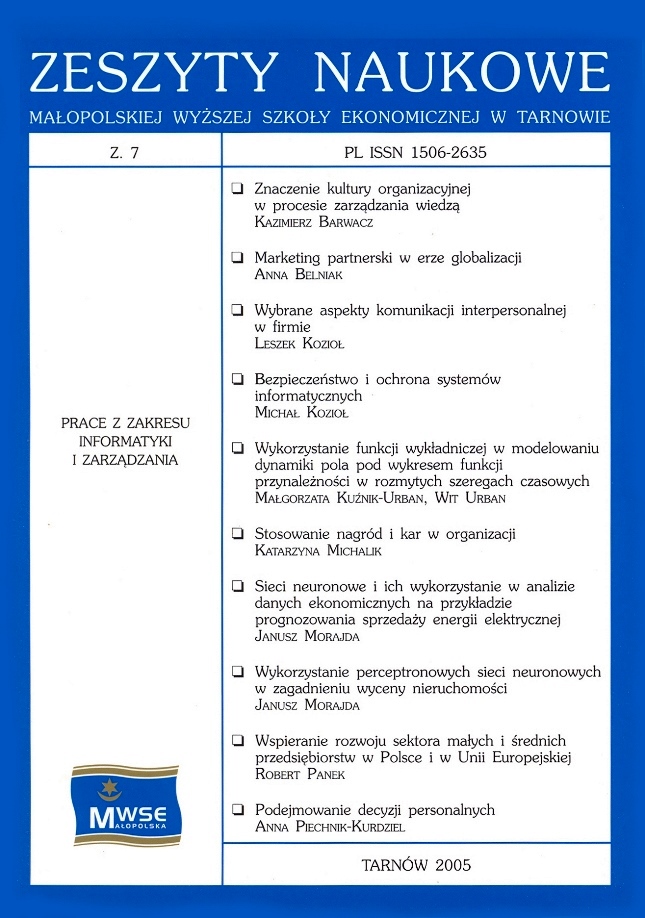Abstrakt
Celem artykułu jest zaprezentowanie procedury zmierzającej do uzyskania formalnego opisu zbieżności funkcji przynależności do postaci graficznej, wykorzystującej zasady arytmetyki rozmytej oraz wskaźnik pola pod wykresem funkcji przynależności liczby rozmytej. Pierwsza jego część stanowi odwołanie do terminologii oraz podstawowych definicji teorii zbiorów rozmytych, ze szczególnym uwzględnieniem arytmetyki rozmytej. Następnie uwaga została zwrócona ku kwestiom związanym z uwarunkowaniami numerycznymi zjawiska chaosu deterministycznego w rozmytych szeregach czasowych. W kolejnej części opracowania znalazły się właściwe rozważania odnośnie do analizy zbieżności funkcji przynależności do postaci granicznej dla przypadku zmiennej rozmytego równania różnicowego. W tym też kontekście występuje propozycja wykorzystania jednego ze wskaźników skalarnej analizy rzeczywistych liczb rozmytych.
Bibliografia
Anile A. M., Deodato S., and Privitera G., Implementing fuzzy arithmetic, Dipartimento Di Matematica, Università Degli Studi Di Catania, Italy 1994.
Zobacz w Google Scholar
Chang W. K., Chów L. R., Chang S. K., Arithmetic operations on level sets of convex fuzzy numbers, Fuzzy Sets and Systems, 1984.
Zobacz w Google Scholar
Forrester J. W., Principles of systems, Industrial Dynamics (MIT Press, Cambridge Mass.), 1968.
Zobacz w Google Scholar
Hanczar P., Symulowane wyżarzanie - optymalizacja procesów logistycznych [w:] Ekonometria czasu transformacji, praca zbiorowa pod redakcją A.S. Barczaka, WU AE, Katowice 1998.
Zobacz w Google Scholar
Homer J. B., Why we iterate: scientific modeling in theory and practice, „System Dynamics Review" 1996, Spring, vol. 12, p. 1-19.
Zobacz w Google Scholar
Kaufmann A., Gupta M. M., Introduction to Fuzzy Arithmetic: Theory and Applications, New York: Van Nostrand, 1985.
Zobacz w Google Scholar
Klir G. J., Pan Y.: Constrained fuzzy arithmetic: Basic questions and some answers, Soft Computing 2 (1998), no. 2, p. 100-108. 7
Zobacz w Google Scholar
Munakata Y., Fuzzy systems: An Overview Communications of the ACM, 1994, March, vol. 37, no. 3 p. 69-76.
Zobacz w Google Scholar
Navara M, Zabokrtsk'y Z.: Computational problems of constrained fuzzy arithmetic. In: The State of the Art in Computational Intelligence, P. Sinc'ak, J. Vasc'ak, V. Kvasnicka and R. Mesiar (eds.), Physica-Verlag, Heidelberg; New York 2000, p. 95-98.
Zobacz w Google Scholar
Resnick R., Halliday D., Fizyka, PWN, Warszawa 1973.
Zobacz w Google Scholar
Schuster H. G.: Chaos deterministyczny. Wprowadzenie, Wydawnictwo Naukowe PWN, Warszawa 1995.
Zobacz w Google Scholar
Song Q., Leland R. P. and Chissom B. S., A new fuzzy time-series model of fuzzy number observations, „Fuzzy Sets and Systems", 1995, August, vol. 73, p. 341-348.
Zobacz w Google Scholar
Turksen L. B., Stochastic Fuzzy Sets, A Survey Lecture Notes in Economics and Mathematical Systems series, Vol. 310, Springer 1988, p. 168-183.
Zobacz w Google Scholar
Urban W., Wykorzystanie teorii grawitacji w analizie funkcjonowania systemów społeczno-ekonomicznych, ZN AE, Kraków 2002.
Zobacz w Google Scholar
Urban W., Wprowadzenie do skalarnej analizy chaosu deterministycznego w przestrzeni rozmytych liczb rzeczywistych, ZN AE, Kraków 2001.
Zobacz w Google Scholar
Urban W., Podstawy rozmytej dynamiki systemowej, AE, Kraków 1999.
Zobacz w Google Scholar
Wołoszyn J., Urban W., Symulacyjna aproksymacja uwarunkowań numerycznych wykorzystania ogólnej teorii grawitacji do opisu relacji społeczno-ekonomicznych, ZN AE, Kraków 2002.
Zobacz w Google Scholar
Wołoszyn J., Urban W., Koncepcja filtru aproksymująco-przeskalowującego w działaniach arytmetyki rozmytej, AE Kraków 2001.
Zobacz w Google Scholar
Wołoszyn J., Elementy teorii chaosu deterministycznego w badaniach systemów ekonomicznych, ZN AE nr 551, Kraków 2000.
Zobacz w Google Scholar
Wołoszyn J., Grafy rozmyte i możliwości ich wykorzystania w ekonomii, Zeszyty Naukowe AE, Seria Specjalna; Monografie, nr 90, Kraków 1990.
Zobacz w Google Scholar
Zadeh L. A., Fuzzy Logic, Computing with Words, IEEE Transactions on Fuzzy Systems, 1996, May, vol. 4, p. 103-111.
Zobacz w Google Scholar
Zadeh L. A., Fuzzy sets and their application to pattern classification and clustering analysis in [VanRysin1977].
Zobacz w Google Scholar
Zadeh L. A., Fuzzy sets, „Information and Control" 1965, no. 8.
Zobacz w Google Scholar
Zieliński J. S., Inteligentne systemy w zarządzaniu. Teoria i praktyka: praca zbiorowa, Wydawnictwo Naukowe PWN, Warszawa 2000.
Zobacz w Google Scholar
© Copyright by Małopolska Wyższa Szkoła Ekonomiczna w Tarnowie. Artykuły są udostępniane na podstawie Creative Commons Attribution Uznanie autorstwa - Użycie niekomercyjne - Bez utworów zależnych 4.0 Licencja Międzynarodowa


